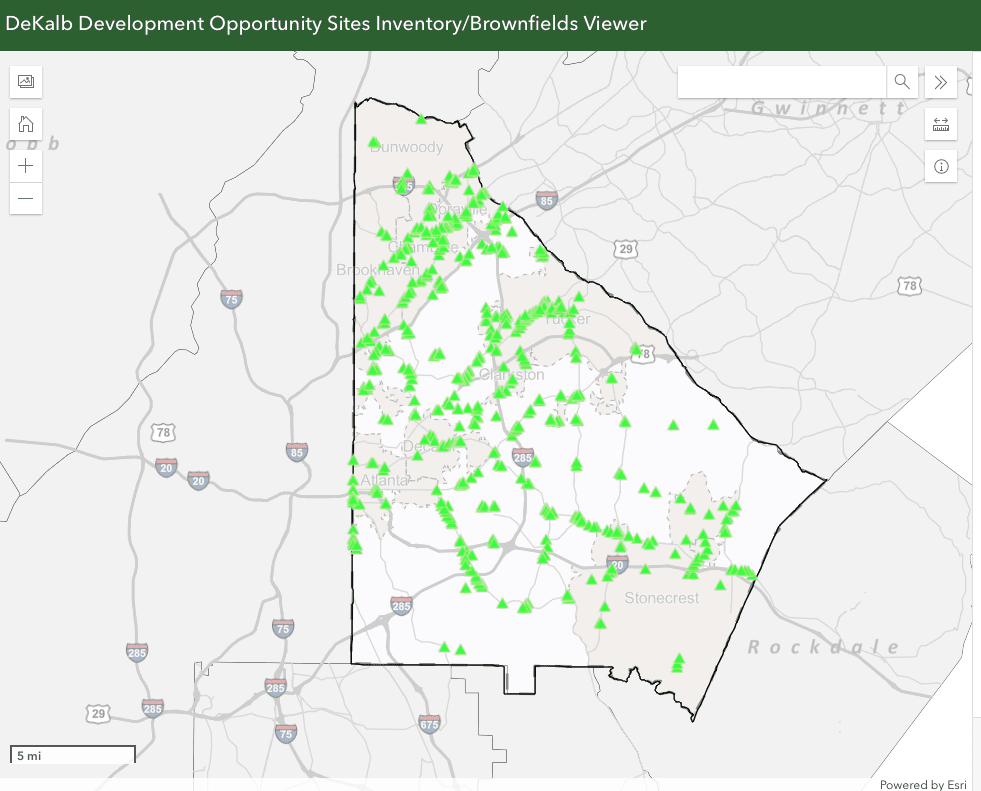
Taking properties from blight to bright — new ‘brownfield’ mapping tool details development opportunities for contaminated sites
While DeKalb County is booming, as people and businesses are drawn to the county’s array of cultural, educational and entrepreneurial opportunities, there’s one area of opportunity that a new tool is bringing to light: Brownfields.
Brownfields are former industrial or commercial sites where future use is affected by environmental contamination. These could include former gas stations, dry cleaners or industrial sites – all which need to be cleaned up before they can be put to new uses.
Now, developers have a new tool to find brownfield sites and potentially qualify for funding to clean them up so the land can go from “blight” to bright.
The new brownfield GIS tool is a collaboration with the county’s economic development authority, Decide DeKalb, and DeKalb County and offers a one-stop shop for developers, investors and citizens who want to know about properties across DeKalb that can be redeveloped or whether a particular site is polluted.
“The GIS brownfield tool addresses DeKalb County’s pressing demand for viable development properties and the unfortunate reality – not uncommon in communities across the country – that some land remains unused because of prior pollution and industrial contamination,” said DeKalb County Board of Commissioners Presiding Officer and District 1 Representative Officer Robert Patrick. “We’re proud that my office could provide funding for the tool, which we believe is the first GIS tool dedicated to brownfield sites in Georgia.”
DeKalb County already has spurred successful redevelopment of notable brownfield sites working with the U.S. Environmental Protection Agency. Three recent examples include the former GM auto plant in Doraville, which has been transformed into Assembly Atlanta, a sprawling movie and TV production campus; Pullman Yards, the old railroad car storage and repair facility which is becoming a bustling entertainment complex; and the East Decatur Greenway, a recreational walking and bike path that once hosted a gas station so polluted the stream running through it – once declared dead – is now home to new aquatic life.
“I’ve been so pleased with the reimagining of the old GM site in Doraville which is in my district,” said Patrick. “It’s a classic lesson in how government can combine resources for environmental cleanup that spurs redevelopment.”
How it works
The web-based brownfield tool, created for DeKalb County by the Cardno Infrastructure GIS & Asset Management group, offers a layered county-wide map detailing hundreds of properties, each of which can be selected to view with details including its owner and the type of potential hazard.
An interested developer might then look into buying the property. There is, for example, an abandoned dry cleaning shop in a Stone Mountain shopping center that could partner with Decide DeKalb – which maintains a revolving brownfield redevelopment fund – to help pay for the property’s cleanup.
“This project will yield tremendous rewards for the county’s businesses and residents,” said Decide DeKalb President Dorian DeBarr. “Too many opportunities are lost or on hold because properties are just sitting there when they could be used for so much more, whether it’s for commercial use or the enjoyment of our residents as we see with the East Decatur Greenway, which went from brownfield to recreational resource for DeKalb residents.”
DeKalb CEO Michael Thurmond said the brownfields project responds to an often-repeated plea from developers and investors for help in clearing unforeseen regulatory hurdles, and is also a common-sense use of taxpayer resources.
“In my view, this is a win-win-win,” said Thurmond. “The development community has an easily accessible resource for potential projects and what challenges they may present; the citizens of DeKalb County will see potentially hazardous properties assessed, cleaned up and redeveloped; and – most of all – the environment is better for everyone who lives, works and plays in DeKalb County.”
For more information on the development opportunity sites inventory and brownfield viewer, please contact Yvette Humphries at Decide DeKalb at [email protected].
